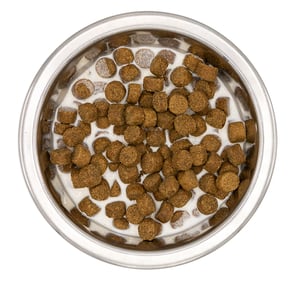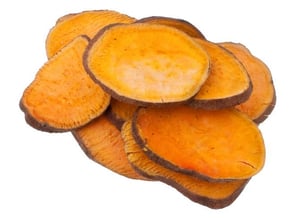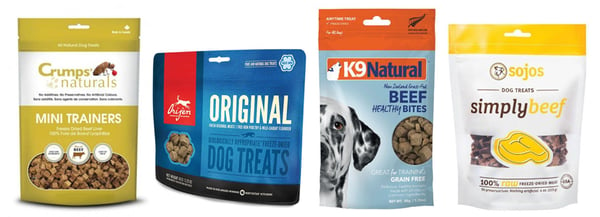.webp)
Is your dog missing a few teeth? Maybe more than a few? Learn how the needs of your toothless dog are not that much different of a chewing-abled dog.
It’s normal for dogs to lose teeth during their puppy stages, but into adulthood, tooth loss is less common. Whether it’s caused by poor dental health issues, injury, or age, your toothless dog is going to need a little extra dog tooth care to protect whatever he’s got left, even if it’s just gums.
Not every dog that we call "toothless" is missing all of its adult teeth. Many dogs, especially those whose teeth have been pulled due to periodontal disease or tooth rot, may be missing just enough adult teeth dogs to make eating a bit more challenging.
If your dog is missing molars and premolars, this can significantly impact its ability to chew hard or crunchy foods. This affects the food, treats, and toys that you chew for your pooch.
Dental Care for Toothless Dogs

Whether your dog has no teeth or just a few, you still need health care for the remaining teeth and gums. Regular tooth brushing is still necessary to eliminate your dog's bad breath and to massage their gums.
It may feel silly to brush your dog's toothless gums, but it can stimulate the gums to improve blood flow and remove bacteria and debris that can accumulate in the small crevices in their mouth.
Learn how to brush dog teeth cleaning, or in this case, mostly gums, in How to Brush Your Dog's Teeth in 10 Simple Steps. Stick to gentle strokes and very soft brushes when you are brushing their gums.
What to Feed a Dog With No Teeth
Can toothless dogs eat kibble? What's the best food for dogs with no teeth? Whether they are 100% toothless or just missing some vital chewing molars, some types of dog food are better suited than others.
To help you find the right dog diet for your toothless wonder, we’ve broken down some of the best food formats for toothless dogs.
Kibble for Toothless Dogs

I know we said kibble can be risky, but there are ways to work around that. First, start by picking a kibble with smaller-sized pieces. Even for larger breed dogs, smaller pieces can reduce the choking risks.
You can also break up your dog’s larger kibble with a rolling pin and a freezer bag instead of buying a whole new formula.
Next, you’ll need to add some warm water to it. The warm water will absorb into the kibble and soften it so that your dog can mush the pieces easily with his tongue and gums. Let the kibble soak for a few minutes before feeding.
Pro Tip - For a little extra flavour, you can use chicken broth or goat’s milk instead of warm water to soften the kibble pieces. This can help to boost calories and nutrition, especially if your dog is eating less than usual due to pain or recovery.
For small and toy breeds, you should take it a step further by running the kibble through the blender or wet food processor before rehydrating. The final texture will be very similar to a pate wet food formula, which will be much easier for a dog with no teeth to eat.
Moistened kibble should be treated like a canned food processor and should not be left out for longer than 30 minutes. Store uneaten portions in the fridge until your dog's next meal.
Wet Food for Toothless Dogs

Wet dog foods, like canned, tetra paks, and pouch formulas, are more often the right texture for a dog without teeth. You can easily adjust the thickness by adding water or chicken broth to make it easier to lap it up like a liquid.
Make sure you stick to wet foods that don’t have large chunks. These can easily be a choking hazard if the pieces are too firm or large for your dog to mash and safely swallow.
Dehydrated Food for Toothless Dogs

If your dog is accustomed to a raw or high-protein food diet, then feeding a freeze-dried or dehydrated food might be the best choice.
Most freeze-dried and dehydrated foods are finely ground or flaked, like Primal Pet Food, so they quickly absorb moisture and leave a smooth pate texture. These minimally processed dog foods are easy to digest and calorie and nutrient-dense, so you can feed your dog smaller, more manageable portions.
If the soft food diet you choose is raw, then your dog will benefit from the bacteria-fighting enzymes in raw meat. Raw dog food diets help to control bad-breath-causing bacteria in your dog's mouth. This won’t replace toothbrushing, but it will help improve their oral health issues.
Other Tips for Caring for Your Toothless Dog
You might assume that your dog with no teeth will miss out on a lot of typical dog experiences, like chewing and toys. To put that myth to rest, let’s talk about all the ways that dogs with no teeth can still enjoy the finer things in dog life.
Toys for Toothless Dogs

Teeth or no teeth, all dogs like to chew. Try offering your dog a soft rubber chew toy, like a puppy Kong. Even if they are just gumming it, they will still enjoy the chewing experience. It helps to massage the gums and gives them a fun activity during downtime.
You can even spice up his chew by adding a small dab of dog-safe peanut butter or coconut oil to the toy. It will provide a good tongue and jaw workout for your toothless wonder.
Chews for Dogs with No Teeth

Many natural chews are too hard for a dog with no teeth to enjoy safely, but that doesn’t mean that he’s totally out of luck. There are some chews that are soft enough for your dogs to gum, like dehydrated sweet potato chips.
One of our favourite treat brands is Crumps' Natural Sweet Potato Fries Dog Treats.
Pro Tip: These can be made at home. Check out this simple recipe to make some chewy, toothless-dog-approved, natural sweet potato chews.
It’s best to always monitor your dogs with any chew, especially a toothless dog. Make sure they are taking their time and softening the chew until they can break off small pieces that are safe to swallow.
Even if they just lick it to death, it will still be a fun and yummy distraction.
Treats for Toothless Dogs

A lot of treats are crunchy kibble, like biscuits and jerky, but this doesn’t mean there aren’t tons of tasty options for treating a dog that’s lacking dog's teeth. Freeze-dried treats are very flavourful and easy to gum.
Here are a few of our top freeze-dried treats that are safe for agomphious dogs of any size:
Stick to treats and toys that are appropriately sized for your dogs. Small breed dogs will need extra small treats. Large breed dogs will need toys big enough that they can’t try to swallow them. Safety first, always.
Toothless Takeaways
So, what can you take away from this article?
Well, we learned that no matter how many dog's teeth your dog has left, dental care is critical. Find a routine that works for your pet, and be consistent.
Food doesn’t have to be a struggle for toothless dogs. While the formats may change to accommodate their limited chewing abilities, the quality and nutrition of the food diet don’t have to.
Lastly, we learned that no matter how many or how few teeth your dog has, they still want the same basic things as a dog with a full set of chompers - something tasty, something fun, and of course, your undivided attention and, unconditional love.
Frequently Asked Questions
What can cause a dog to lose its teeth?
Tooth loss in dogs can be caused by various factors, including dental disease, trauma, genetic predisposition, or age-related issues.
How can I tell if my dog is missing teeth?
You can check your dog's mouth for missing teeth by gently lifting their lips and examining their gums and teeth. You may notice gaps, empty spaces, or signs of tooth decay or gum disease.
Do dogs require special care if they're missing teeth?
Yes, toothless dogs may require special care. It's essential to feed them soft or moistened food to make eating easier. Regular dental check-ups with your veterinarian are also crucial to monitor their oral health.
Can a toothless dog still eat regular dog food?
Toothless dogs may struggle to eat regular dry kibble. It's often recommended to switch to soft or moistened dog food to accommodate their needs and make mealtime more comfortable.
How can I keep my toothless dog's mouth clean and healthy?
You can maintain your toothless dog's oral health by regularly cleaning their gums and any remaining teeth with a soft brush or gauze. Dental hygiene is essential to prevent further dental issues.
Are there any dental toys or products designed for toothless dogs?
Yes, there are dental toys and chews designed for toothless dogs. Look for soft, rubbery toys or dental chews that can help keep their gums healthy and provide oral stimulation without the need for teeth.
.png?width=200&height=66&name=logo%20(1).png)





.jpg)
